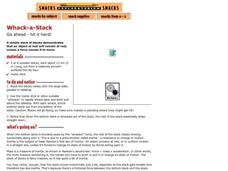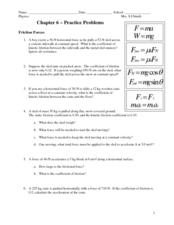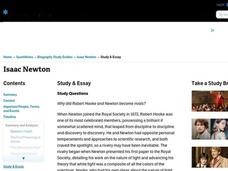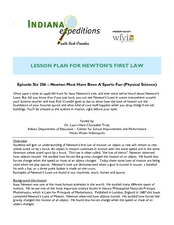Exploratorium
Whack-a-Stack
Go wild as you hit a stack of wooden blocks to demonstrate Newton's first and second laws of motion. The blocks at the top of the stack stay put as you knock one at a time out of the bottom. Note, however, that you will need to visit a...
Teach Engineering
Physics Tug of War
Slide books with a little assistance from Newton. Using books, groups create a demonstration of Newton's Second Law of motion. Pupils compare the distance traveled by one and two books when they apply a force to them.
Curated OER
CPO Science - Foundations of Physics
An object in motion will remain in motion, and your physics learners will really get moving by viewing this PowerPoint! They examine each of Newton's laws of motion, learning about force, inertia, acceleration, and equilibrium. They are...
Curated OER
Free Up the Ketchup!
Learners, in teams, use given materials and their knowledge of Newton's First Law to create a device that will remove a sticky ping pong ball from a 16-oz. cup (which represents ketchup stuck in a bottle.)
Teach Engineering
May the Force Be With You: Thrust
Force the plane through the air. The lesson introduces the force on an airplane that makes it go forward. Pupils learn how Newton's laws of motion apply to flight in the eighth segment of a 22-part unit on flight.
Curated OER
F = ma, Inertia, and Action-Reaction
Fourth graders apply concepts of Newton's Laws in scientific inquiries. Use this instructional activity to have your charges test and identify the characteristics of objects that make them easier or harder to push. After a teacher-led...
Curated OER
Unit V: Worksheet 2 - Constant Force
Physics learners studying force and acceleration practice solving eight problems with this assignment. They calculate acceleration and deceleration, net force, and distances required for stopping a moving object. Kinematics equations and...
Curated OER
Action-Reaction! Rocket
Students construct a rocket from a balloon propelled along a guide string. They use this model to learn about Newton's three laws of motion, examining the effect of different forces on the motion of the rocket. They measure the distance...
Curated OER
Leading Scientist of the Scientific Revolution
Quiz your class on how well they know the leading scientist of the scientific revolution. They answer seven multiple choice questions that require them to know each major contribution of each of the following scientists: Galileo, Newton,...
Curated OER
3-2-1 Pop!
Students investigate how rocket liftoff demonstrates Newton's Laws of Motion. They participate in a class discussion, and construct a rocket powered by the pressure generated from an antacid tablet reacting with water.
Curated OER
Chapter 6 - Practice Problems: Forces
Zip through 13 physics problems with force! Equations are printed in large text in the upper-right corner of the page. Pupils change friction forces, deal directly with Newton's second and third laws of motion, and name fundamental...
Curated OER
Newton's Second Law of Motion with Balance Toys
Students discuss acceleration and deceleration and participate in brief demonstrations of the Second Law of Motion. They apply the law to a metal balance toy and a plastic balance toy by applying the same force then with different forces.
Curated OER
Writing Exercises: The Scientific Revolution III
In need of a writing prompt to accent your next lesson on the scientific revolution? This handout includes three short-answer questions that ask learners to describe the effect of the revolution on religion, what they would do if they...
Curated OER
Momentum Worksheet
Young Newtons solve nine momentum problems on a physics homework assignment. They tell which moving object has more momentum, compute average force, determine velocity, and more. Using this resource, you can assess your physics pupils'...
Curated OER
Balloon-Powered Car
Attractive and logical instructions are provided for constructing a balloon-powered car. Young physical scientists measure the distance their car travels and record it on a pre-printed data sheet. The make alterations to improve the...
CK-12 Foundation
Newton's Apple
Scientists state that the higher something is above the earth, the greater the gravitational potential energy. Does this mean there is more gravity acting on the moon than on an apple falling from a tree? Scholars adjust the distance...
Institute of Electrical and Electronics Engineers
Playing with Parachutes
This lesson certainly will not be a drag! Little engineers design parachutes that make use of air resistance and, as a result, slow the descent of the payload as much as possible. It is an opportunity to teach about many motion concepts:...
Curated OER
3-2-1 Pop!
Pairs of space scientists or junior physicists construct and deploy antacid-powered rockets. Through this activity, they observe Newton's Laws of Motion. The plan is detailed and well-organized. Resource links include professionally...
Curated OER
Sir Isaac Newton and His Laws of Motion Hunt
In this Sir Isaac Newton worksheet, students use links provided to complete answer to questions related to Newton and his "laws." Worksheet included extended thinking activities.
Curated OER
Isaac Newton
In this online interactive history quiz worksheet, learners respond to 10 short answer and essay questions about the life and accomplishments of Isaac Newton.
Curated OER
Newton Word Search
In this science worksheet, students find the words that are related to the laws of motion and the work of Sir Isaac Newton. The answers are found by clicking the button found at the bottom of the page.
Curated OER
Newton's Laws
In this motion worksheet, young scholars read about the 3 laws of motion and then complete a graphic organizer describing the laws and giving an example for each one.
Education World
Every Day Edit - Sir Isaac Newton
Practice everyday! Have learners correct grammatical errors in a short paragraph about Sir Isaac Newton. The errors are in capitalization, punctuation, spelling, and grammar.
Curated OER
Newton Must have Been a Sports Fan
Students examine Newton's Laws. In this law of motion lesson, students observe Newton's three laws of physics demonstrated by the teacher. They apply other examples to Newton's first law of inertia.

























